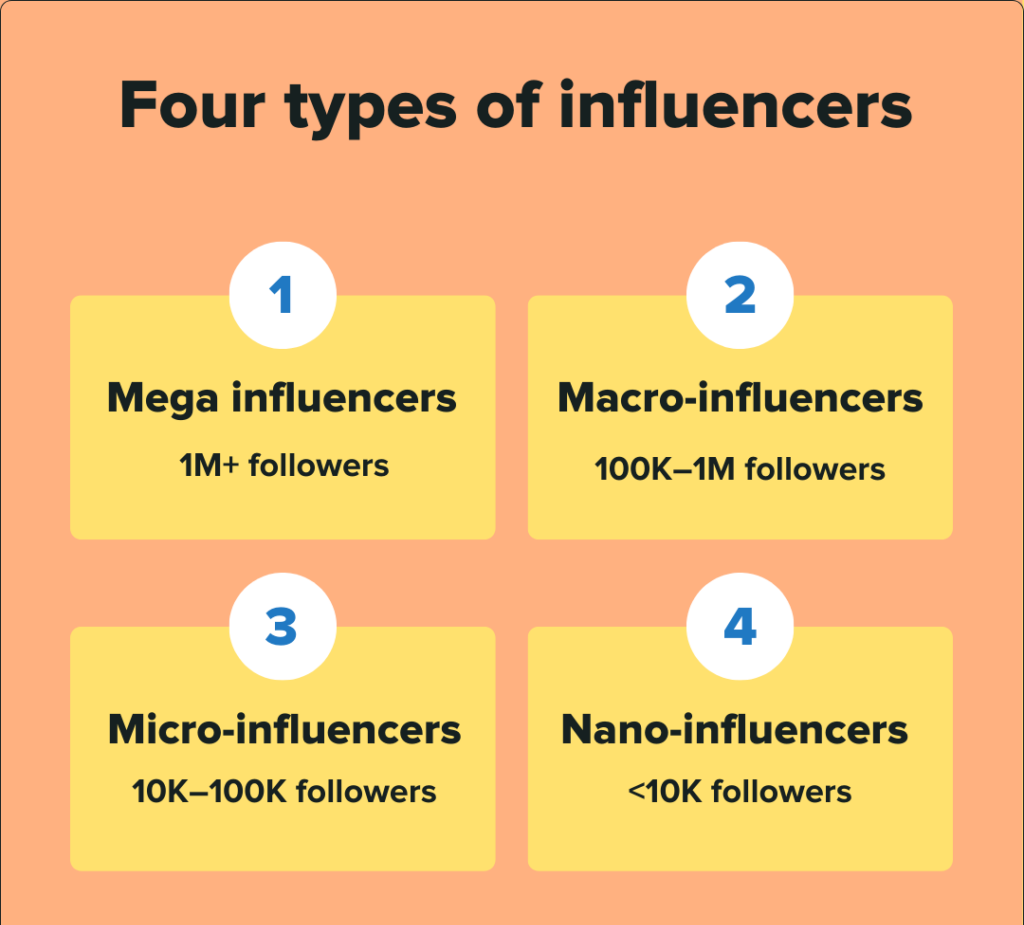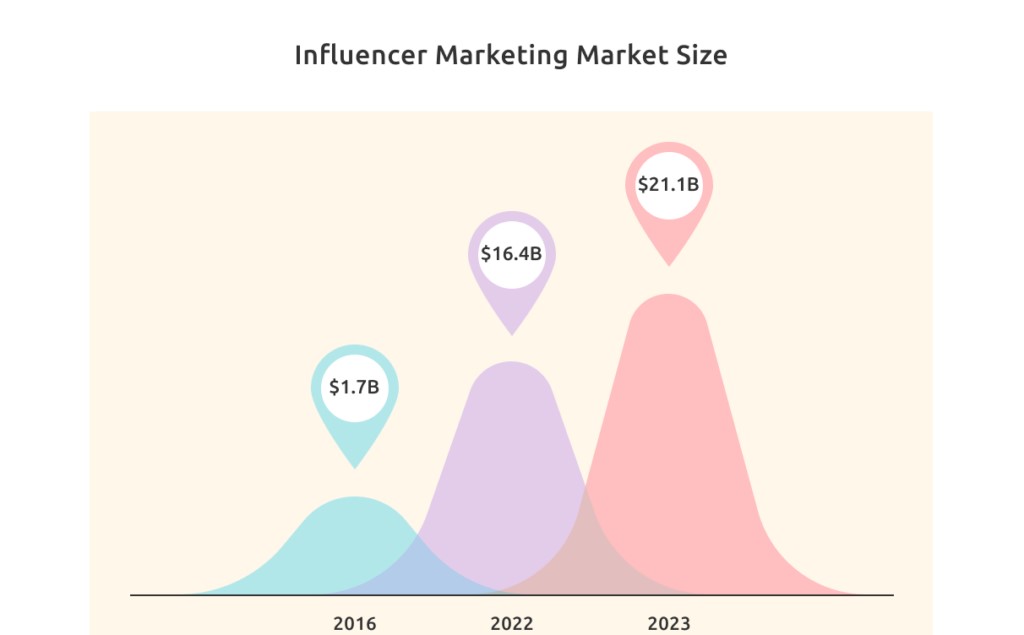Influencer marketing could be a good choice if you’re considering promoting on social media.
What is influencer marketing? It means teaming up with people who have lots of followers on social media to promote your stuff.
Nowadays, loads of folks use social media every day. People trust the folks they follow. So, it’s smart for businesses to reach out to those social media stars with lots of followers and likes. Working with influencers helps get your products and services in front of many people, which could boost your sales.
To make the most of Influencer Marketing, you need a solid plan. But before we talk about that, let’s go over what it is, how it works, and if it’s right for your business.
Different kinds of influencers exist in influencer marketing, each with unique characteristics.
While teaming up with a famous influencer who has millions of followers may seem ideal, it might only sometimes align with your brand’s goals. Some influencers have large, diverse audiences across various demographics. Others maintain smaller but highly engaged communities.
Understanding the different types of influencers, including their reach, diversity, cost, and engagement levels, is crucial when selecting the right ones for your brand.
Let’s delve deeper into the various categories of influencers available:

Mega or celebrity influencers
These influencers have a huge following, often exceeding 1 million people. They include well-known actors, singers, athletes, and other public figures. Their fame allows them to attract a wide range of people, making them great for spreading the word about brands to many.
Big influencers can give your brand a lot of attention, but teaming up with them can cost a lot of money. Also, because their audience is so diverse, they might not get as many people interacting with their content compared to influencers with smaller, more specific groups of followers.
Here are some types of businesses that might find it useful to work with big influencers:
- Big companies with lots of money to spend
- Brands that want to reach many different kinds of people
- Expensive or luxury brands that want to make people feel special
Macro-influencers
These influencers typically have followers ranging from 100,000 to 1 million. They are well-known figures within their specific areas of interest.
Medium-sized influencers have built their reputation by consistently creating engaging content over time. They are seen as leaders in their field.
Collaborating with medium-sized influencers offers a more focused approach compared to celebrities because their followers usually share similar interests. Working with them can help your brand reach a significant audience, although it might still require a considerable budget.
Here are some examples of brands that might partner with medium-sized influencers:
- New companies aiming for quick exposure, growth, and credibility (for instance, Canva)
- Charitable organizations hoping to raise funds and awareness
- Hotels and airlines targeting a specific but sizable audience
Micro-influencers
These influencers have between 10,000 to 100,000 dedicated followers who actively engage with their content. They are becoming increasingly popular in influencer marketing and are prominent on platforms like Instagram, YouTube, and TikTok.
Marketers find small influencers appealing because they connect with a specific, enthusiastic audience through their authentic content, relatable suggestions, and genuine interactions.
Moreover, they are more cost-effective than larger influencers. However, this doesn’t mean they are less effective. Research indicates that small influencers have a 60% higher engagement rate than medium-sized influencers and can generate 20% more conversions for your brand.
Nano-influencers
Nano influencers have less than 10,000 followers. However, they often have strong bonds with their audience due to their relatable content and genuine interactions. Although they reach the smallest audience, tiny influencers can be valuable partners for businesses aiming to connect with specific groups and demographics affordably. It’s no surprise that more brands are looking to collaborate with tiny influencers in 2023. Moreover, because tiny influencers operate on a small scale, they can devote more attention and energy to individual partnerships. This results in more customized content for your brand and personal connections within specialized communities.
Examples of businesses that might benefit from partnering with tiny influencers include:
- Local businesses focusing on specific communities, cities, or regions
- Small businesses with limited budgets seeking cost-effective marketing campaigns
- Artisan, home-based, or specialty food businesses targeting a niche audience interested in unique products.

Why choose influencer marketing?
Considering that 56% of young Americans have bought a product after seeing a post from someone they follow, influencer marketing can be a highly effective tool for promoting your brand.
According to data from Influencer Marketing Hub, the industry hit $21.1 billion in 2023 and is projected to reach $26 billion in 2024.
The study also delves into how marketers view influencer collaborations for the upcoming year.
Among those surveyed, 83% regarded influencer marketing as a successful marketing strategy. The study also revealed that 67% of marketers intend to increase their budgets for influencer marketing in 2024.
Now that you’re aware of the current state of the industry, let’s explore some common challenges marketers encounter when navigating the realm of influencer marketing.

Is influencer marketing suitable for your business?
Both B2B and B2C companies can see advantages from influencer marketing. If you implement this strategy well, you can expand your audience.
However, it’s worth noting that B2B companies don’t commonly use influencer marketing. So, if you operate in the B2B sector, you must carefully consider how to collaborate with an influencer who can effectively boost your brand visibility and target the appropriate audience.
On the contrary, for B2C businesses, influencer marketing can be a potent strategy to boost revenue.
How to develop an influencer marketing plan
To make the most of your influencer marketing plan, you should consider these crucial steps:
- Set clear goals. Determine what you aim to achieve. How will you measure success? Having well-defined goals is essential for a successful influencer marketing campaign.
- Understand your audience. Take a close look at your target audience. Who are they? What challenges do they face? Which social media platforms do they frequent? Understanding these aspects helps you connect with your audience effectively.
- Establish a budget. Having a budget in place helps you determine how much you can invest in influencer marketing. This is particularly important if you plan to compensate influencers directly for their services.
- Identify the right influencers. Take your time to find influencers who align with your brand. Who do you want to collaborate with? Who follows them? Do you prefer social media personalities or individuals with a substantial following in a specific industry?
- Monitor metrics and refine your strategy. Keep track of your campaign’s performance metrics. How effective is your influencer campaign? Are there areas that need improvement? Regularly monitoring metrics allows you to refine and optimize your strategy accordingly.

Benefits of Influencer Marketing in Digital Landscape Today
In the modern digital era, influencer marketing has emerged as a potent tool for businesses aiming to connect with fresh audiences and enhance brand visibility. It involves collaborating with individuals who boast significant followings on social media and various online platforms to endorse a brand’s products or services.
Here are several key advantages of influencer marketing:
- Expanded reach and engagement: Influencers possess pre-existing audiences that trust and actively follow their content. Brands can tap into these audiences to attract new potential customers through influencer partnerships.
- Enhanced credibility: Influencers are often perceived as authorities or trendsetters within their respective niches. By associating with an influencer, a brand can leverage some of that credibility to bolster its reputation.
- Targeted outreach: Influencer marketing empowers brands to pinpoint specific demographics or audience segments, ensuring that their message reaches the right individuals.
- Creative content: Influencers are renowned for their ingenuity and distinctive viewpoints. Collaborating with influencers enables brands to tap into this creativity, producing content that resonates with their target audience authentically and engagingly.
- Increased sales and ROI: Influencer marketing has been shown to deliver tangible business outcomes, with studies indicating a potential return on investment of up to $18 for every dollar spent.
Nevertheless, it’s crucial to emphasize that effective influencer marketing necessitates meticulous planning and execution. Brands must select suitable influencers to partner with, formulate a coherent strategy, and ensure that the content aligns with their brand ethos and messaging.
In essence, influencer marketing stands as a potent asset for brands seeking to connect with fresh audiences, establish credibility, and drive tangible business outcomes in today’s digital realm. By collaborating with influencers and harnessing their unique perspectives and creativity, brands can craft targeted, compelling content that resonates with their desired audience and delivers measurable results.
Conclusion
In conclusion, influencer marketing is a powerful tool in today’s digital landscape, enabling businesses to connect with diverse audiences, boost brand visibility, and drive results. From mega-celebrities to nano-influencers, there’s a range of options to tailor campaigns based on goals, budget, and target audience. Statistics underscore its efficacy and growing prominence, with consumers often making purchasing decisions based on influencer recommendations.
Success in influencer marketing requires clear goals, understanding the audience, selecting the right influencers, and monitoring performance metrics. It is a dynamic tool for brands seeking meaningful connections with consumers and sustainable growth in the digital marketplace. As businesses adapt and innovate, strategic influencer partnerships remain crucial for success in today’s interconnected world.

